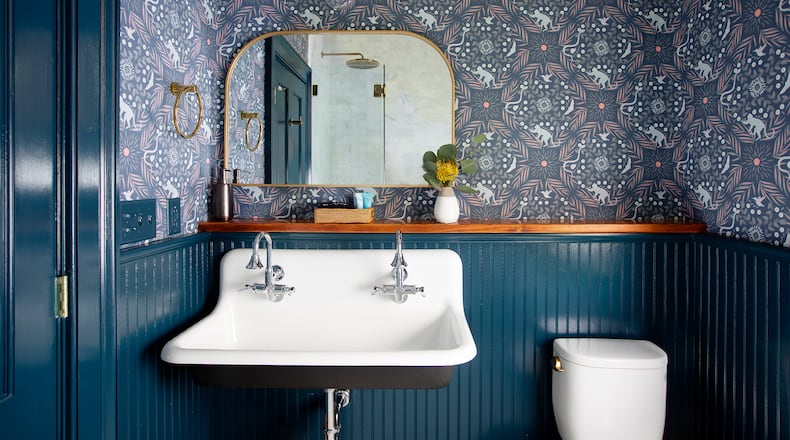For some, it’s gone the way of the avocado-green fridge and wall-to-wall carpeting — a remnant of the past. But wallpaper has witnessed a revival in recent years due to its passionate fans and despite its committed detractors.
“Wallpaper can have the reputation of being a dated interior choice,” said Atlanta native Katie Deedy, who graduated from Decatur’s Agnes Scott College and now owns wallpaper design business Grow House Grow in Brooklyn.
“I personally grew up with ’70s-style yellow vinyl wallpaper in my kitchen, not exactly the airy and modern look that has thrived in the past decade or two,” she said.
Wallpaper’s prospects are looking up. The global market for wallpaper is expected to grow steadily over the decade, from $1.7 billion last year to $2.4 billion by 2030, according to Grand View Research.
It’s popping up on powder rooms walls and even on dining room ceilings. It’s showing up in hip hotels and Airbnb apartments. It’s grabbing the attention of interior designers. And it’s enticing renters, who can turn to the peel-and-stick version to add instant personality — and still remove it to get their security deposit back.
“Wallpaper is the quickest and most effective way to customize your space to feel unique to you,” said Maggie Samson, interior design and trade sales executive at U.K.-based luxury wallpaper company House of Hackney.
Credit: Courtesy of House of Hackney
Credit: Courtesy of House of Hackney
Haters argue that wallpaper can be hard to remove and lock them into a design feature they might later regret.
“Paint is easy and can feel more accessible,” Deedy said. “Wallpaper takes a little more planning and has a permanence to it that may not work in some spaces. But once installed, its impact is worthy of the extra TLC it can call for.”
Samson notes that the wallpaper of today is not your mother’s or your grandmother’s variety.
“Wallpaper previously had a much harder application process that was daunting and limiting for many people to take that plunge,” she said. “This has drastically changed in the past 15 to 20 years, and we’ve come such a long way to streamline the install process completely to be a DIY project.”
In the past, wallpaper was first soaked to activate the adhesive and then applied to the wall, a fairly messy job. Today, you first coat the wall with adhesive and then apply the wallpaper, making it easier to smooth the surface and remove lumps and bumps as you go. And even easier, the peel-and-stick variety of wallpaper simply entails removing a backing and then pressing it to the wall.
Credit: denisismagilov - stock.adobe.com
Credit: denisismagilov - stock.adobe.com
The cost can range from a mass-produced roll for $20 to an artist-designed roll that can range from $200 to $350. On the higher end especially, wallpaper has evolved with an incredible variety of patterns from artists and other creative types.
Faye Bell is one of them. An Atlanta artist and wallpaper designer, Bell attended New York’s Pratt Institute and initially planned a career in the visual arts but then launched her first wallpaper collection in 2018. She mostly sells through showrooms directly to interior designers, but you can check out her designs in the bathrooms at Colony Square’s Politan Row food hall in Midtown.
For skittish types wanting to dip a toe in wallpaper without an all-in commitment, Bell advises installing wallpaper behind the shelves on bookcases to allow the pattern to peek through. That’s also less expensive, since you are using less product.
But if your fear of trying something with character and personality is the issue, she recommends just going for it and embracing what you love.
“If you’re not planning to sell your house in the next five years, you can make bolder choices,” Bell said. “Even if it’s a neutral, adding a pattern is just going to bring you joy.”
Deedy’s wallpaper designs are inspired by her family’s love of storytelling. Like so many contemporary wallpaper designers who prize wit and inventiveness, her fanciful patterns feature monkeys, dandelions, praying mantises and even house flies.
Credit: Courtesy of Grow House Grow
Credit: Courtesy of Grow House Grow
“I think the best way to describe what I’ve been seeing is modern with a mix of whimsy,” Deedy said. “We’re moving just a little bit away from the simplicity of Scandinavian aesthetic, and embracing deeper colors and punchier designs.”
The beauty of contemporary wallpaper is the variety, Samson said, ranging from “bold, vivid and daring prints” to “more toned-down neutrals” to “reimagined” florals “that are not your granny’s classic.”
House of Hackney specializes in designs like Samson’s favorite, “Blackthorn Climbing Walls,” adapted from a pattern by renowned 19th-century textile designer William Morris.
“It is a traditional William Morris print designed in 1892, but we have reimagined the print with more gothic tones,” she said.
Credit: Courtesy of House of Hackney
Credit: Courtesy of House of Hackney
In one more tweak to the past, wallpaper is now ending up in different areas than it did in previous decades. Some people are even using it on ceilings.
“The ceiling is always the most ignored wall in the room,” Samson said. “Wallpaper on a ceiling feels fresh and can be the quickest way to make a space feel larger as it draws your eye up and touches every corner of a room without overwhelming the room’s design.”
Katie Deedy’s wallpaper tips
- Order a little more paper than your exact measurements, at least 10% to 15% more, just to make sure you have a little extra to play around with during the learning curve.
- Apply the “measure twice, cut once” rule when installing wallpaper. It can save you a lot of grief.
- Keep in mind, some walls, ceilings and floors aren’t perfectly straight. It’s important to start with a true “plumb” line using a level and straight edge to keep your wallpaper strips aligned correctly.
- The Wallcovering Installers Association is a great resource for DIY tips or for qualified professional installers if you need a hand.
Unique wallpaper brands
House of Hackney: houseofhackney.com/us
Grow House Grow: growhousegrow.com
Fine and Dandy: fineanddandycompany.com
Faye Bell: fayebell.com
Isobel: shopisobel.com
The Lawns: thelawnsco.com
Abnormals Anonymous: abnormalsanonymous.com
Thatcher Studio: thatcherstudio.com
Wow Papers: wowpapers.com
Felicia Feaster is a longtime lifestyle and design editor who spent 11 years covering gardening, interior design, trends and wellness for HGTV.com. Felicia is a contributor to MarthaStewart.com and has been interviewed as a design expert by The New York Times, Forbes and the Associated Press.
About the Author
Keep Reading
The Latest
Featured






